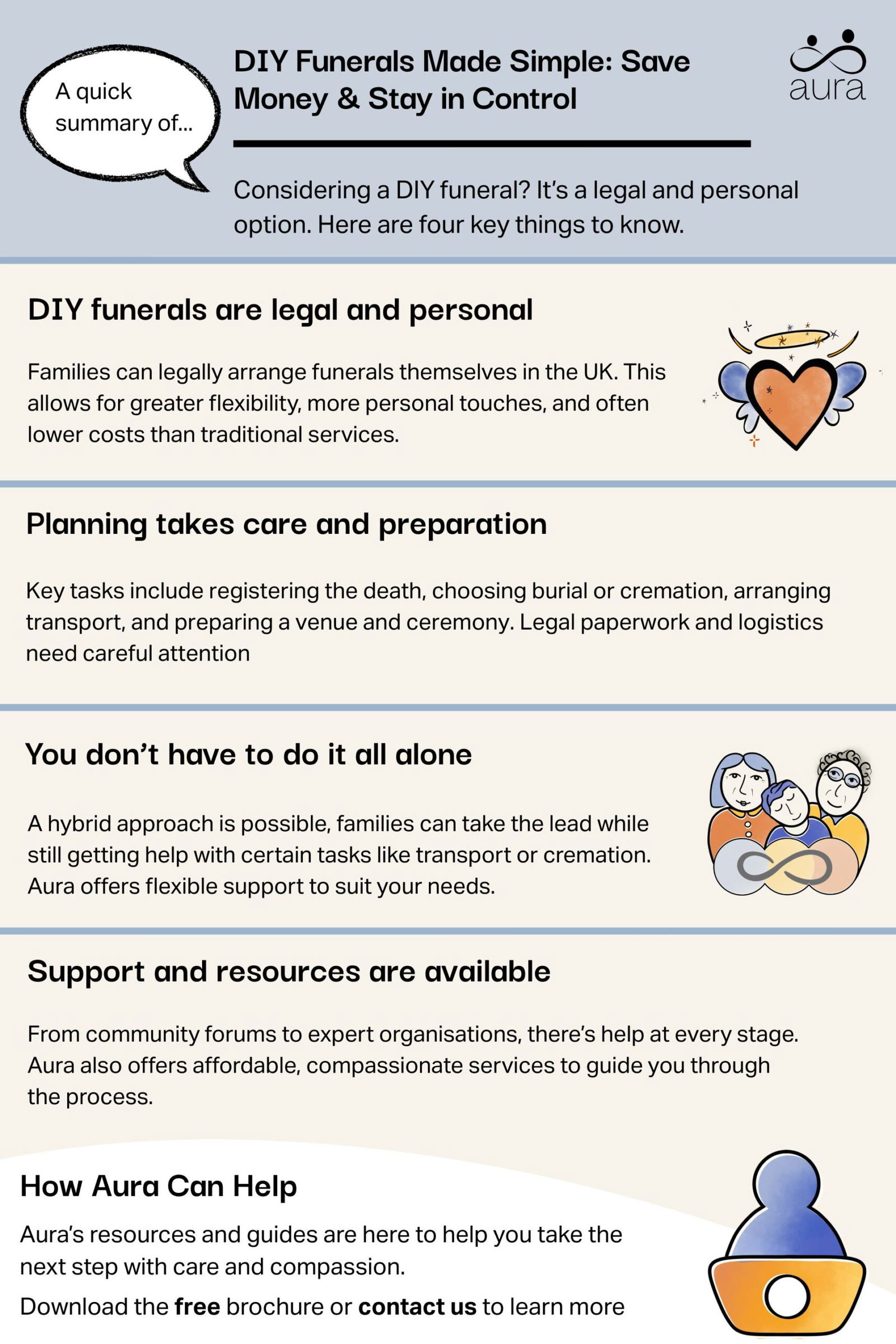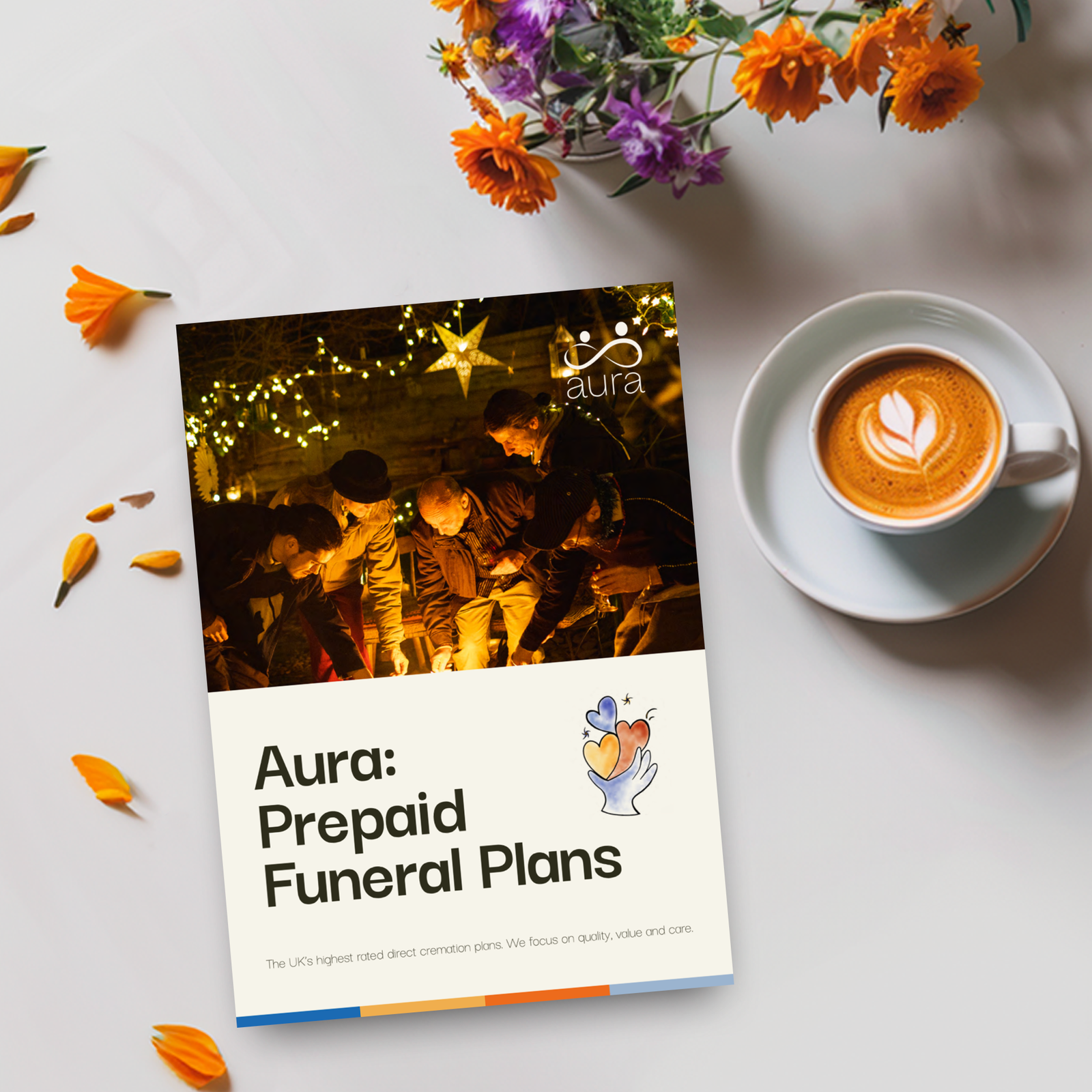


Written by Emily Cross.
22 minute read
Article reviewed by Judy Carole, Published Author on May 16, 2025.
Saying goodbye to a loved one is, for some, one of the most emotionally taxing and challenging periods in life. For many, taking the lead in planning the service offers a way to pay tribute to their loved one’s life in a more intimate way. Do-it-yourself or ‘DIY’ funerals—where families take responsibility for arranging the ceremony and its practical elements—are becoming an increasingly popular choice in the UK.
While the idea of organising a funeral independently may feel daunting at first, it can also be an empowering way to navigate grief, providing a sense of purpose and connection during a potentially challenging time. If you’re here in search of some guidance, we hope to provide some helpful insight. With the right guidance and support, planning this type of funeral can become a powerful act of love.
Key takeaways:

DIY funerals can provide families the opportunity to arrange a funeral service for their loved ones without the involvement of traditional funeral directors. Many people are surprised to discover that this is a completely legal and viable option, dispelling the common funeral myth that organising a funeral yourself isn’t allowed. Using this approach allows for the possibility of greater personalisation and potential for a more low cost funeral compared to many professionally managed funerals.
These funerals offer families complete control over every aspect of the process, from organising transportation to selecting burial or cremation options. If your loved one has shared their wishes in a funeral plan or end-of-life plan, it provides valuable guidance to ensure their preferences are honoured exactly as they envisioned. For many, this flexibility feels more meaningful and in tune with their values than a traditional funeral.
Though planning a DIY funeral can certainly be rewarding, it comes with some extra considerations:
Assigning specific tasks to trusted family members or friends can help to lighten the burden. Seeking advice for complex matters, such as legal paperwork, to ensure compliance can also help to ease stress.
Planning a funeral doesn’t have to be entirely DIY or fully managed by a funeral service. If a more hands-on approach to planning a funeral feels like a little bit too much, Aura can provide compassionate guidance and support to help ease the process.
A hybrid approach allows you to take an active role in organising certain aspects of a funeral while receiving professional support where needed. At Aura, we can assist with key elements like arranging a low cost cremation, transporting your loved one, or helping with paperwork, while you focus on personal touches such as the decorations, readings, celebrant or a celebration of life.
This flexible approach offers the best of both worlds. You can create a tailored and unique service while ensuring that complex or technical tasks, such as liaising with a crematorium or managing legal requirements, are handled smoothly by our team of experienced professionals. It’s a way to honour your loved one by playing an active role, with the reassurance that Aura is here to guide and support you when needed.
If you’re exploring your funeral options and think you might want a little help planning a funeral for yourself or for a loved one, Aura is here for you. As a top-rated provider of direct cremation services and prepaid funeral plans in the UK, we are committed to offering empathetic, affordable, and personalised support to help families honour their loved ones. Our 4.9/5 stars on Trustpilot reflects the care and compassion we provide to the families who place their trust in us.
Aura’s family-run ethos is at the heart of everything we do. Founded by Paul Jameson and his son David alongside their family friend Ben. Their vision was inspired by Paul’s personal confrontation with mortality, during which he recognised the importance of ensuring his family would have clarity, unwavering support, and care in his absence. This heartfelt vision became the foundation of Aura, built on the belief that every family deserves the same level of respect and care we would want for our own loved ones.
Our dedicated team of Aura Angels extends that respect and care to every person that chooses Aura, and provides seamless service from start to finish.

If you’d like to know more about how to plan a cremation with Aura, our brochure is a helpful place to begin.
Our funeral plans are a helpful way to put everything in place for you or someone else.
When the time comes, our experienced team will be here to guide you through each step, offering support and advice whenever you need it.
To find out more about how our plans work, what’s included, and our story, you can request a brochure by clicking the link below. We will then send you a copy by email or First Class post—whichever you prefer.
The first step in arranging a funeral is registering the death. In England and Wales, this must be done within five days of the person’s death(eight days in Scotland). The medical certificate of cause of death (MCCD) will be sent to the registrar, and families will be notified when they can register. Once registered, the registrar will issue the Death Certificate and a Certificate for Burial or Cremation (known as the “green form” and is only issued in England and Wales), which is required to proceed.
If the death was unexpected or occurred under unusual circumstances, it may be referred to the coroner or procurator fiscal in Scotland. This may delay the registration process until a cause of death is determined.
Permits and regulations
Families planning a DIY funeral must adhere to burial and cremation laws. For burials on private land, permission from the local council may be necessary. Additionally, cremation requires specific forms, including cremation applications and medical forms completed by doctors. Understanding these regulations is crucial to making sure the process is handled respectfully and legally. Consulting our cremation forms guide can help you to navigate this process more easily.
Selecting between burial and cremation is one of the most significant choices you’ll need to make when planning a DIY service. When deciding, it’s important to take into consideration the wishes of the person who has died, if they had expressed any. You should also be sure that the choice aligns with any known faith-based preferences or traditional customs in accordance with beliefs on death and funerals in their religion. You might also consider factors like environmental impact and cost.
For burials, families can select between traditional cemeteries, private land (with permissions), or natural burial sites. Each option has its own costs and regulations. Burial provides a physical place of remembrance and offers several options for location:
Cemetery burial
Cemetery burials have long been the traditional choice for commemorating loved ones in the UK. Rooted in cultural and religious customs, they offer families a dedicated place to visit and reflect.
Fees can vary widely depending on location. In urban areas, burial plots tend to be more expensive. Families may purchase a single or family plot, and headstones or markers can be added if desired.
Natural burial sites
These eco-friendly burial sites are a sustainable option for those who valued nature. Loved ones are laid to rest in biodegradable coffins or shrouds using nature-friendly methods. Many natural burial sites encourage tree planting or wildflower areas instead of headstones.
Private land
In the UK, it is legal to bury someone on private land with the landowner’s permission. You must notify the local council to update land records and make sure the burial site is suitable –away from water sources and in compliance with environmental regulations.
For cemetery or natural burial funerals, begin by doing a search to find your preferred local cemetery and contact their office. Most cemeteries have contact information on their website and sometimes additional details regarding plots and their associated prices and add-ons.
You can then arrange the burial date and location, and submit the required documentation, including the Certificate for Burial or Cremation (green form), and the burial application. If a coroner was involved, you would need an ‘Order for Burial’ (form 101) instead of the green form. These arrangements and submitting of documents can all be done in person or over the phone/email.
Cremation is an increasingly popular choice for families seeking simplicity and flexibility. It is often more affordable and offers options for memorialising ashes. Cremation requires coordination with a crematorium and submission of cremation forms, which may vary depending on the location.
Research local crematoria and select one based on criteria important to you, such as location, cost, and services offered. Contact the crematorium directly to discuss available dates, times, and any additional options. Many crematoria offer both attended and unattended options.
Once you’ve booked the cremation, you can submit the required paperwork to the crematorium and schedule the date. For cremations, you will need the Cremation Certificate (green form), Cremation Application (‘Form 1’ in England and Wales, ‘Form A’ in Scotland), and the MCCD.
If the death was referred to a coroner, medical certificates will not be required. Instead, you will receive ‘Form 6’ in England and Wales or ‘Form E’ in Scotland.
Attended vs unattended cremation
When arranging a cremation, you’ll need to choose between an attended or unattended service. An attended cremation allows family and friends to be present, often with a short service. An unattended cremation happens without any mourners, offering a simpler and more private option. Understanding these choices can help you decide what’s best for your loved one’s farewell.
Memorialising ashes
Afterwards, cremation ashes can be memorialised in various ways. This can include scattering ashes in a meaningful location or holding an ash scattering ceremony, burying or interring them them in a cemetery, garden, or on private land, or keeping them in an urn at home or divided among family members. They can even be incorporated into keepsakes, or fireworks.

Transportation is a crucial aspect of planning a funeral, as it involves respectfully and legally moving the person who has died to the chosen location for burial or cremation. It may be one of the more intimidating steps of a DIY funeral, but there are several straightforward options to ensure this process runs smoothly and is handled with care.
If you’ve cared for your loved one at home, placing them into their coffin or shroud can be straightforward, though you might require assistance. It’s best to have trusted people on hand to call if you do need help with handling your loved one.
For collections from a hospital mortuary, staff can assist with placing your loved one into the coffin, dressing them, and potentially removing medical devices. If it feels overwhelming to see your loved one in that environment, let the staff know beforehand so they can act accordingly.
Make sure you know what paperwork you need to bring ahead of time, such as a green form. The mortuary will provide a trolley for transport, and lining your vehicle with plywood can make loading easier.
Using a personal vehicle
Families may use their own vehicle for transportation of the person who has died. Estate cars, vans, or large SUVs are often suitable, but should be measured ahead of time. Make sure that the vehicle is clean and prepared with a flat, stable surface to securely hold the coffin or shroud. Take a route that avoids excessive traffic to minimise potential delays.
Hiring a private ambulance or specialist service
Several companies offer private ambulance services for transporting a person who has died These services often include professional handling and vehicles designed for this purpose.
This option is ideal for longer distances or if families prefer professional assistance.
Natural burial or local arrangements
For natural burials or burials on private land, transporting the deceased may require coordination with the burial site to ensure access and compliance with local guidelines.
Tips for a smooth process:
For long-distance or international transport in DIY funerals, careful planning is essential to meet legal, logistical, and practical requirements. Repatriation for international transport involves permits, death certificates, and compliance with the regulations of both departure and destination countries.
For long-distance transport within the UK, you’ll need a suitable vehicle to safely and respectfully transport the coffin. It’s important to plan the route, allow for sufficient time, and confirm that the destination (such as a crematorium or burial site) is prepared to receive the coffin on arrival. You can also notify the police before you set off to help avoid misunderstandings or delays during your journey, though it’s not a legal requirement.
Whether domestic or international, expert advice or assistance ensures the process is handled smoothly and with dignity.
Documentation and professional services
Additional paperwork, such as a death certificate, embalming certificate, or coroner’s letter, may be required for long-distance or international transportation.
International transportation is best handled by specialist companies experienced in repatriation and compliance with legal regulations. These companies handle logistics, coordinating with airlines, embassies, and funeral providers to ensure respectful and efficient transportation. While families can technically handle this, managing the sometimes intricate legal and logistical requirements can present challenges.
Coffin or shroud options for DIY funerals
Selecting a coffin or shroud for a DIY funeral is an important decision. It offers families the chance to pay tribute to a loved one’s memory in a meaningful way. There are a variety of options available, ranging from traditional to eco-friendly designs, balancing cost, environmental considerations, and personalisation.
Coffin options
Coffins are the most commonly used choice for both burials and cremations. With a DIY funeral, families can source or even create their own coffin, provided it complies with legal requirements.
Options include traditional designs, often made from wood or metal, offering durability and a classic look. Eco-friendly coffins, crafted from biodegradable materials like cardboard or bamboo, are ideal for reducing environmental impact and are made to suit a range of budgets. For a more unique tribute, personalised coffins can feature custom decorations or messages, and some families decide to build or decorate their own, provided it meets legal requirements for transport and burial or cremation.
Purchasing a coffin
Some suppliers will sell coffins directly to the public, but it’s important to check the requirements of your chosen crematorium or cemetery before ordering. Ensure the coffin is the correct size, allowing a little extra space, and that it can safely accommodate the weight. Opt for a coffin with load-bearing handles and arrange for enough people to carry it on the day of the funeral.
Shroud options
A shroud is a piece of fabric used to wrap a body for burial or cremation, and a practical and minimal alternative to a coffin. Traditionally made from natural materials like cotton, wool, or hemp, shrouds are often used in eco-friendly or green burials because they decompose naturally.
Families can also create DIY shrouds from natural fabrics, quilts, or even bed sheets, personalising them with decorations, provided they are strong enough for transport and burial. Shroud boards, often used for added support, are inexpensive and can be purchased or handmade.
When choosing a venue, consider locations that reflect your loved one’s personality, such as a family home for intimacy, gardens for tranquillity, community halls for larger gatherings, or outdoor spaces like parks or beaches for their symbolic significance.
Venue preparation checklist:
Once you’ve chosen a location, it’s important to prepare the space for a relaxed and meaningful day. Arrange seating, decorations, and personal touches like flowers or photos to set a comforting atmosphere. Designate a central area for the ceremony, providing accessibility for all guests, and test any sound equipment in advance. If providing refreshments, create a convenient setup, and for outdoor venues, plan for unexpected weather with marquees or umbrellas.
Tips for a smooth setup
A DIY funeral ceremony offers families the freedom to create a unique service that reflects their loved one’s life. Thoughtful planning helps ensure the ceremony is both comforting and memorable. Start by deciding on the tone –traditional or non-traditional formal or informal – and choose a venue that resonates.
Having an outline will help keep the event organised and flowing smoothly.
The ceremony can include a welcome speech to set the tone, eulogies sharing memories, meaningful readings or poems, and favourite music, whether recorded or live. You can also add moments of reflection, like a silence or symbolic gestures such as lighting candles or releasing flowers.
Delegating roles
Assigning tasks to family members, friends or chosen professionals can take some pressure off and ensure the ceremony runs seamlessly. Examples include:
How you choose to end the ceremony has a lasting impact on the memories of those in attendance. Consider the following:
For families considering a DIY funeral, a range of support resources is available:
DIY funerals offer an empowering way for families to celebrate life, honour their loved ones, and reduce costs. With careful planning, support, and personalisation, this approach can create a deeply meaningful service. For those seeking more assistance, Aura can help.
Aura is proud to serve mainland Britain with our range of services, including intimate farewell funerals, fully attended ceremonies and unattended options. Our unattended cremations start at £1,195, which is less than half of the national traditional average of £4,285, according to SunLife. If you’d like to learn more about how we can help, we are just a phone call away.



If you have any questions, would like a brochure or simply would like a chat through our services, our award-winning team is here to help.
Unlike other providers, we won’t hassle you with constant calls. We’ll simply ensure you have the information you need and leave you to come to a decision in your own time. When you’re ready for us, our team will be ready to help.
A DIY funeral is when family or friends arrange and manage a funeral without hiring a traditional funeral director. It’s completely legal in the UK and can allow for greater personalisation, more meaningful involvement, and reduced costs.
To have greater control over the ceremony and arrangements.
To create a more personal and intimate farewell.
To save money compared to traditional funeral services.
To reflect the wishes of the person who has died more closely.
Yes. There is no legal requirement to use a funeral director. However, you must register the death, obtain the proper paperwork (e.g. MCCD, green form), and comply with burial or cremation regulations.
Confirm crematorium or cemetery policies (some may require a funeral director).
Arrange for pacemaker removal before cremation, if applicable.
Hire a gravedigger if needed.
Manage legal documents, transportation, and venue setup carefully.
Assign roles to friends or family to share the workload.
No. Many families choose a hybrid approach—handling personal touches themselves while getting professional help for complex tasks (e.g. cremation arrangements, transport, paperwork). Aura can support families with these elements.
Register the death (within 5 days in England and Wales; 8 in Scotland).
Obtain the Death Certificate and Certificate for Burial or Cremation.
If the death is referred to a coroner, wait for the appropriate forms (e.g. Form 6 in England & Wales).
Follow local laws for burial or cremation.
Yes, it’s legal to bury someone on private land with the landowner’s permission and local council notification. The site must comply with environmental and health regulations, including distance from water sources.
Attended cremation: Family and friends are present for a short or full service.
Unattended cremation (direct cremation): No ceremony at the crematorium, with ashes returned afterward for a separate memorial.
You may use your own vehicle (estate car, van, SUV) if properly prepared.
Or hire a private ambulance or specialist service.
For long-distance or international transport, additional paperwork and professional support are often needed.
Coffins can be purchased directly from suppliers or made at home if they meet cremation or burial requirements.
Shrouds (biodegradable fabric wraps) are often used for eco-friendly burials and can be handmade.
Always check your crematorium or cemetery’s size and material guidelines.
Many families choose:
Family homes or gardens
Community halls or village spaces
Natural outdoor settings like woodland, parks, or beaches
Cemeteries or crematoria (if using attended options)
A DIY funeral ceremony can be formal or informal. Common elements include:
Welcome or opening words
Readings, eulogies, or music
Moments of silence or symbolic gestures (e.g. lighting candles, scattering petals)
Farewell or closing gesture
Assigning roles such as an MC, music coordinator, or photographer can help the ceremony run smoothly.
Yes. Support is available from:
Natural Death Centre (guidance on DIY funerals and legalities)
Community forums for shared experiences
UK Government websites for legal requirements
Aura Angels, who can offer professional support where needed
Yes. A prepaid funeral plan can cover the essentials (e.g. cremation costs) while allowing loved ones to personalise the rest. This ensures your wishes are followed and relieves your family of financial and logistical stress.